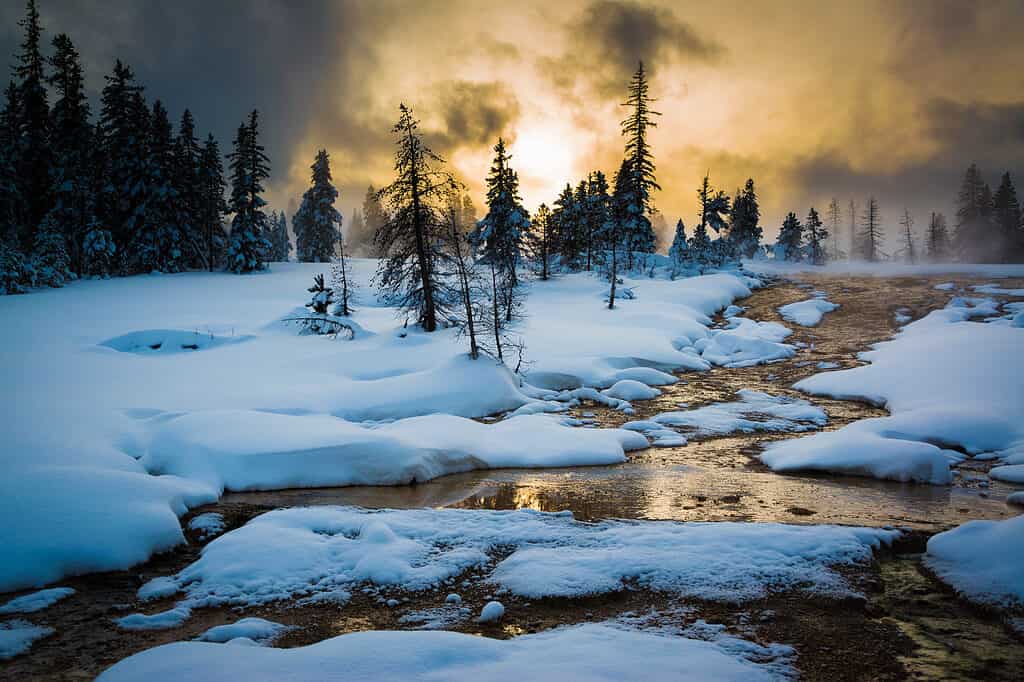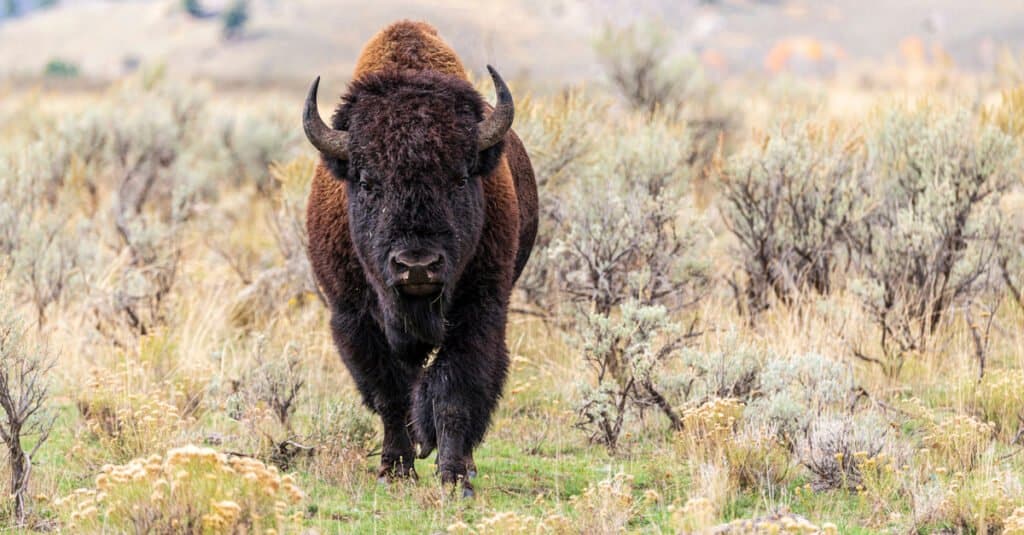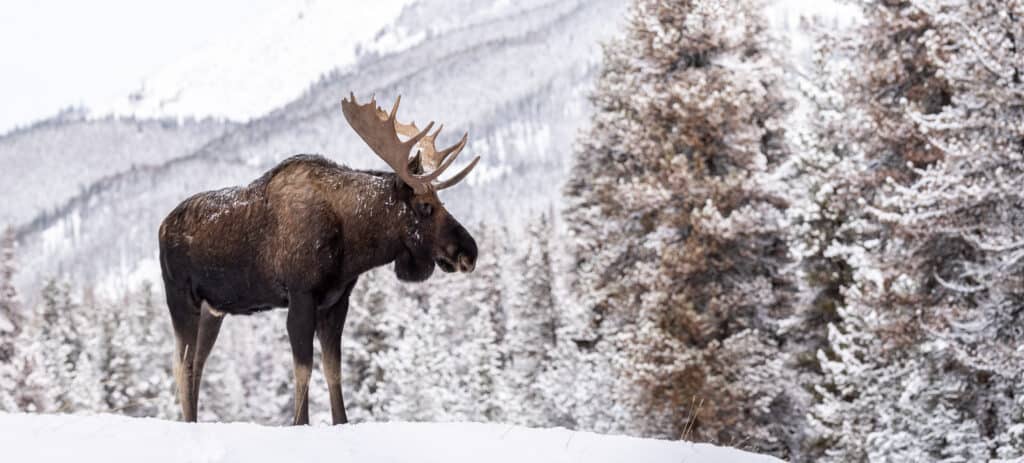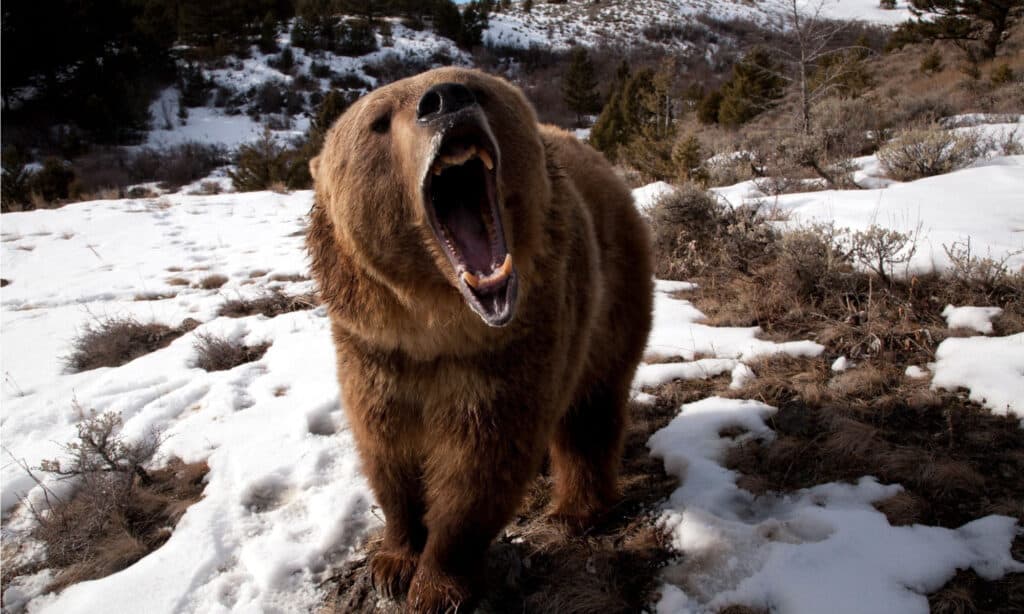Yellowstone National Park is a beautiful outdoor oasis with lots to do and see. The national park sees about 4.86 million visitors a year. It is the country’s oldest national park and is located mainly in Wyoming, with some small parts in Montana and Idaho. Whether you are looking to visit during winter, or you’re just curious, it’s good to know how much it snows in Yellowstone National Park. Follow along to learn more about the national park’s snowfall.
The History of Yellowstone National Park
Yellowstone national park’s history is long, however, long before it became an official national park, humans lived in the region. For instance, Native Americans hunted in the region. It’s thought that humans have been in the region for at least 11,000 years. Yellowstone obsidian was used by Paleo-Indians and made into different tools like arrowheads. The region was very well-known. In fact, the Lewis and Clark expedition was informed of the Yellowstone area by Nez Perce, Crow, and Shoshone tribes, but they didn’t explore it.
The first expedition into the Yellowstone area was the Cook–Folsom–Peterson Expedition of 1869. They started at the Yellowstone River and made their way to Yellowstone Lake. Although people knew of the region, it wasn’t established as a park until March 1, 1872. In its first years as a national park, leaders struggled to enact new laws and regulations, specifically for poaching. There were also conflicts with Native American tribes that used the region seasonally. Native Americans were excluded from the park. One tribe, the “Sheepeaters”, was promised a peace treaty where they would relocate from the park, but still, have the right to hunt in the region. The treaty was never ratified and their claims were dismissed by U.S. officials.

Yellowstone is the country’s oldest national park and is located mainly in Wyoming, with some small parts in Montana and Idaho.
©Storimages/Shutterstock.com
Yellowstone National Park’s Climate and Weather
Since Yellowstone National Park is so large, its climate and weather vary a lot. The temperature depends on elevation. Lower elevations of the park are generally warmer than higher elevations that see higher snowfall. However, because Yellowstone National Park is located in the north, it rarely exceeds 90 °F. The highest recorded temperature in the park was 99 °F in 2002. Summers are warm and sunny, with temperatures ranging from 70 to 80 °F. Nighttime lows, however, drop significantly and can sometimes be below freezing. Spring and fall daytime temperatures average between 30 and 60 °F, while nighttime temperatures are a lot lower, sometimes lowering to single digits. In the winter, daytime temperatures are about 0 to 20 °F, while nighttime temperatures drop well below zero.
Yellowstone National Park also experiences thunderstorms in the summer afternoons. Although tornados aren’t common, they can happen. For example, on July 21, 1987, the Teton–Yellowstone tornado hit the park and left damage. It was 1 to 2 miles wide and leveled 15,000 acres of pine forest. Heavy rain is also common and can sometimes lead to flooding when combined with rapid snow melt.
The Most Snowfall in Yellowstone National Park
The most snowfall in Yellowstone National Park was 355.1 inches in 1996. In one day, the most snowfall received was 30 inches on January 15, 1913. Snow in Yellowstone National Park stays long in winter because of constant below freezing temperatures. Snow can fall during any time of the year, but is most common between November and April. The average snowfall around Yellowstone Lake is 150 inches a year. However, this doubles at higher elevations throughout the park.

Snow in Yellowstone National Park stays long in winter because of constant below freezing temperatures.
©Sebastian Burel/Shutterstock.com
Animals in Yellowstone National Park
The wildlife in Yellowstone National Park is impressive. There are over 300 species of birds alone.
American Bison
The American bison in Yellowstone is a sight to see. They are the largest bison population on land in the country. There are about 4,800 bison in Yellowstone’s herd. American bison are native to North America. They are large animals, sometimes surpassing 1,000 pounds. American bison are the country’s national mammal. These large animals are fast, with a wild lifespan of about 25 years.

There are about 4,800 bison in Yellowstone’s herd.
©Grey Mountain Photo/Shutterstock.com
Elk
You’ll likely see an elk when visiting Yellowstone National Park. They are the most abundant mammal in the park. Sometimes, there are 7 to 8 herds, or 10,000–20,000 elk living in the park during summer. Elk weigh up to 700 pounds and prefer the cold. They are also considered the loudest deer family member. Despite their heavy weight, elk are fast runners. Elk can outrun horses, running as fast as 40 mph.

You’ll likely see an
elk
when visiting Yellowstone National Park.
©Bradley Wakoff/Shutterstock.com
Moose
Although Yellowstone moose are large, they are the smallest subspecies in North America. The moose in Yellowstone National Park are quiet, living in flat forested areas. There are about 400 to 500 moose in the park, and the population has continued to decrease. Moose easily survive the chilling cold winters and deep snow in the park.

The moose in Yellowstone National Park are quiet, living in flat forested areas.
©Harry Collins Photography/Shutterstock.com
Grizzly Bear
Although grizzly bears live in Yellowstone National Park, there are less than 1,000. In 1975, there were only 136. Black bears also inhabit the national park. Grizzly bears are massive and aggressive. You should never interact with them in the wild. Sadly, some grizzly bears have been caught and euthanized for destroying herds of cattle outside of the park. The largest was estimated to weigh 600 to 800 pounds.

Grizzly bears are massive and aggressive
. You should never interact with them in the wild.
©Falade Adewale/Shutterstock.com
The photo featured at the top of this post is © iStock.com/Jonathan Steele
Thank you for reading! Have some feedback for us? Contact the AZ Animals editorial team.






